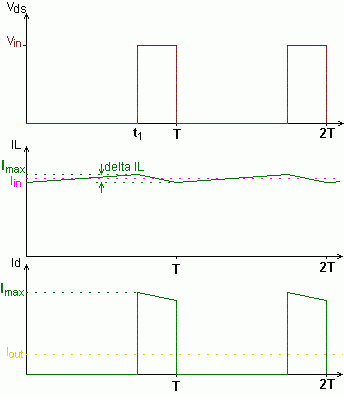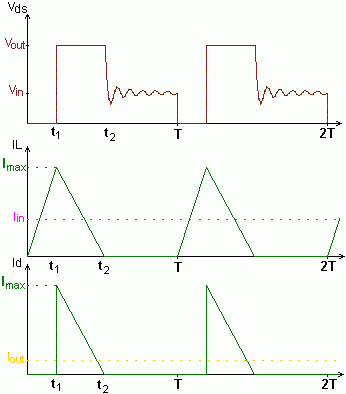Boost Converter
How to use the program
Reference: The shapes of current and voltage curves are calculated using Faraday's Law. They do not represent an incremental simulation like it is done normally by programs like P-Spice. In the calculations the forward voltages of the diodes are considered with VF = 0.7V, and the transistors are interpreted as ideal switches.
- The values of all input fields can be changed.
- If an input field is left empty, a default value is chosen. This value is displayed after leaving the input field in question.
- The switch mode power supply operates within a certain input range i.e. between Vin_min and Vin_max.
- The program needs the output values Vout and Iout.
- The switching frequency f is the operating frequency of the transistor.
- If the field "proposal" is activated, the proposed choking coil L and the current ripple ΔIL are chosen such that ΔIL = 0.4Iin, for Vin_min as the input voltage. (Iin = Iout·Vout/Vin)
- If you should not be content with the proposed values, you can change L or ΔIL. If this is the case, the field "proposal" is deactivated automatically.
- The value Vin is the value for the calculation of the current and voltage diagrams on the right side of the display. Vin must lie between Vin_min and Vin_max.
Top of page
Application:
The Boost Converter converts an input voltage to a higher output voltage. It is also named the step-up converter. Boost converters are used in battery powered devices, where the electronic circuit requires a higher operating voltage than the battery can supply, e.g. notebooks, mobile phones and camera flashes.
Top of page
Function principals:

|
| Illustration 1: Boost Converter
|
The transistor works as a switch which is turned on and off by a pulse-width-modulated control voltage. The ratio between on-time and the period t1/T is called the Duty Cycle.
For the following analysis it will be assumed that the transistor is simplified as an ideal switch and the diode has no forward voltage drop. In the program itself, the diode will take into account a forward voltage drop VF = 0.7V.
During the on-time of the transistor, the voltage across L is equal to Vin and the current IL increases linearly. When the transistor is turned off, the current IL flows through the diode and charges the output capacitor.
The function of the boost converter can also be described in terms of energy balance:
During the on-phase of the transistor, energy is loaded into the inductor.
This energy is then transferred to the output capacitor during the blocking phase of the transistor.
The output voltage is always larger than the input voltage. Even if the transistor is not switched on and off the output capacitor charges via the diode until Vout = Vin. When the transistor is switched the output voltage will increase to higher levels than the input voltage.
- The Boost Converter is not short circuit proof, because there is inherently no switch-off device in the short-circuit path.
A distinction is drawn between discontinuous and continuous mode depending on whether the inductor current IL reduces to zero during the off-time or not.
With the help of Faraday's Law the continuous mode and steady state conditions can be established.

From this it follows that:

- For continuous mode the output voltage is dependent on the duty cycle and the input voltage, it is independent of the load.
In discontinuous mode, the inductor current IL will go to zero during every period. At the moment when the inductor current becomes zero, i.e. t2, the voltage V1 jumps to the value of Vout because in this case VL = 0. The drain-source capacitance in parallel with the diode-junction capacitance forms a resonant circuit with the inductance L. This is stimulated by the voltage jump across the diode. The voltage V1 then oscillates and fades away.

| 
|
Continuous Mode
| Discontinuous Mode
|
Illustration 2: Operating modes of the Boost Converter
Top of page
Tips
- The larger the chosen value of the inductor L, the smaller the current ripple ΔIL. However this results in a physically larger and heavier inductor.
- Choose ΔIL so that it is not too big. The suggestions proposed by us have adequately small current ripple along with physically small inductor size. With a larger current ripple, the voltage ripple of the output voltage Vout becomes clearly bigger while the physical size of the inductor decreases marginally.
- The higher the chosen value of the switching frequency f , the smaller the size of the inductor.
However the switching losses of the transistor also become larger as f increases.
- The smallest possible physical size for the inductor is achieved when ΔIL = 2Iin at Vin_min. However, the switching losses at the transistors are at their highest in this state.
Top of page
Mathematics used in the program
The following parameters must be entered into the input fields:
Vin_min, Vin_max, Vout, Iout and f
Using these parameters, the program produces a proposal for L:

where VF = 0.7V (Diode Forward-voltage) and

For the calculation of the curve-shapes, and also for the calculation of "ΔIL with Vin_min", two cases have to be distinguished, i.e. continuous mode and discontinuous mode:


From this it follows that:
- For ΔIL< 2Iin the converter is in continuous mode and it follows that:



- For ΔIL> 2Iin the converter is in discontinuous mode and it follows that:





![]()







